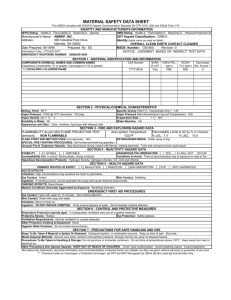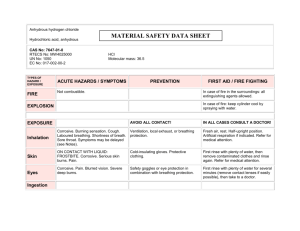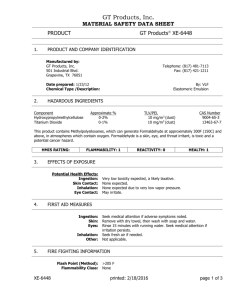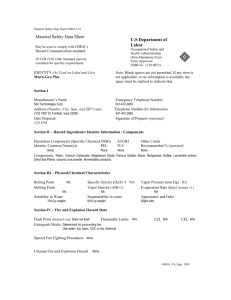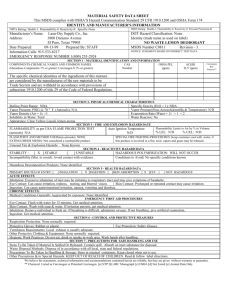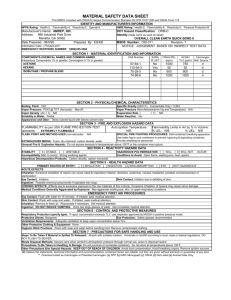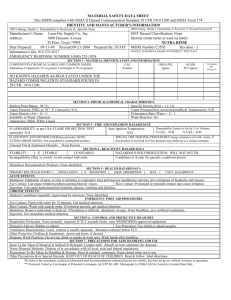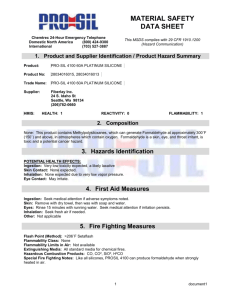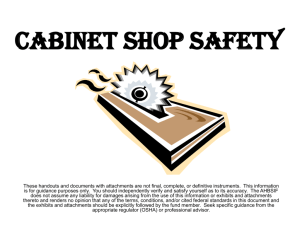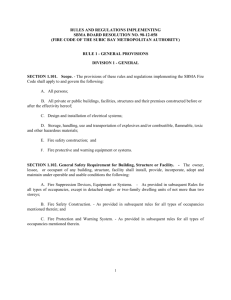Liquid Oxygen Gas - Star Special Gases
advertisement
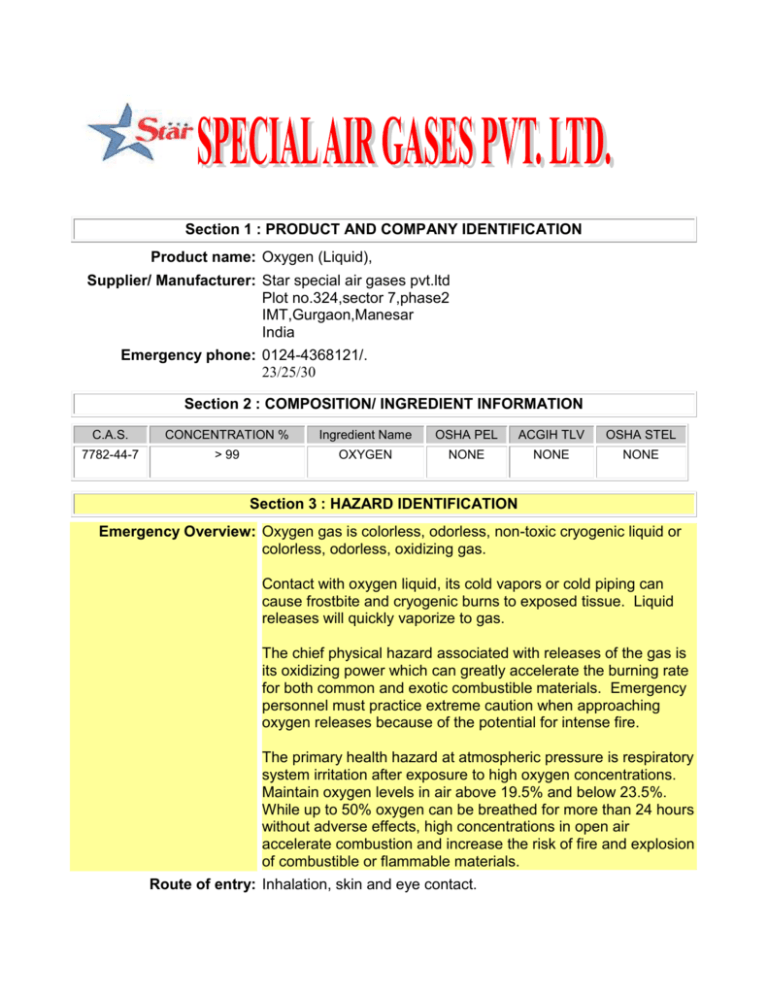
Section 1 : PRODUCT AND COMPANY IDENTIFICATION Product name: Oxygen (Liquid), Supplier/ Manufacturer: Star special air gases pvt.ltd Plot no.324,sector 7,phase2 IMT,Gurgaon,Manesar India Emergency phone: 0124-4368121/. 23/25/30 Section 2 : COMPOSITION/ INGREDIENT INFORMATION C.A.S. CONCENTRATION % Ingredient Name OSHA PEL ACGIH TLV OSHA STEL 7782-44-7 > 99 OXYGEN NONE NONE NONE Section 3 : HAZARD IDENTIFICATION Emergency Overview: Oxygen gas is colorless, odorless, non-toxic cryogenic liquid or colorless, odorless, oxidizing gas. Contact with oxygen liquid, its cold vapors or cold piping can cause frostbite and cryogenic burns to exposed tissue. Liquid releases will quickly vaporize to gas. The chief physical hazard associated with releases of the gas is its oxidizing power which can greatly accelerate the burning rate for both common and exotic combustible materials. Emergency personnel must practice extreme caution when approaching oxygen releases because of the potential for intense fire. The primary health hazard at atmospheric pressure is respiratory system irritation after exposure to high oxygen concentrations. Maintain oxygen levels in air above 19.5% and below 23.5%. While up to 50% oxygen can be breathed for more than 24 hours without adverse effects, high concentrations in open air accelerate combustion and increase the risk of fire and explosion of combustible or flammable materials. Route of entry: Inhalation, skin and eye contact. Effects of acute exposure Eye contact: Can cause frostbite (liquid form). No adverse effects from gas. Skin contact: Can cause frostbite (liquid form). No adverse effects from gas. Inhalation: May cause breathing difficulty. Prolonged exposure to high oxygen levels (>75%) can cause central nervous system depression: signs/symptoms can include headache, dizziness, drowsiness, poor coordination, slowed reaction time, slurred speech, giddiness and unconsciousness. May cause coughing and chest pain. May cause lung damage. May cause soreness of the throat. Ingestion: Not a likely route of exposure. Effects of chronic None known. exposure: Reproductive effects: Oxygen deficiency during pregnancy has produced developmental abnormalities in humans and experimental animals. Section 4 : FIRST AID MEASURES Skin contact: Remove contaminated clothing. Treat for frostbite if necessary by gently warming affected areas. Consult a physician. Eye contact: Immediately flush eyes with plenty of water for at least 15 minutes. Consult an ophthalmologist. Inhalation: RESCUERS SHOULD NOT ATTEMPT TO RETRIEVE VICTIMS OF EXPOSURE TO THIS PRODUCT WITHOUT ADEQUATE PERSONAL PROTECTIVE EQUIPMENT. At a minimum, SelfContained Breathing Apparatus should be worn. Remove victim(s) to fresh air, as quickly as possible. If not breathing qualified personnel should administer artificial respiration. Get medical attention. IKeep person warm and at rest. Ingestion: No first aid should be needed. Not considered a potential route of exposure. Section 5 : FIRE FIGHTING MEASURES Flammability: Oxidizer. Conditions of Contact with flammable materials. flammability: Vigorously accelerates combustion. Extinguishing media: Use appropriate extinguishing media for surrounding fire. Special procedures: Self-contained breathing apparatus required. Firefighters should wear the usual protective gear. Cool fire exposed containers with water spray. Personnel should be evacuated, if necessary, to upwind area. Remove containers from fire area if without risk. Auto-ignition Not applicable. temperature: Flash point (°C), method: Not applicable. Lower flammability Not applicable. limit (% vol): Upper flammability Not applicable. limit (% vol): Explosion Data Sensitivity to mechanical Avoid impact against container. impact: Explosive power: Closed containers may rupture or explode due to pressure buildup when exposed to extreme heat. Section 6 : ACCIDENTAL RELEASE MEASURES Leak/Spill: Evacuate all non-essential personnel. Stop leak without risk. Keep combustible materials away from spill. Ventilate. Eliminate all sources of ignition. Allow to evaporate to atmosphere. Do not walk on or roll equipment over the spill Wear gloves and goggles Ventilate area. Monitor the surrounding area for Oxygen level. Section 7 : HANDLING AND STORAGE Handling procedures and Never allow any unprotected part of the body to touch equipment: uninsulated pipes or vessels that contain cold fluids. The extremely cold metal of the container will cause moist flesh to stick fast and tear when one attempts to withdraw from it. Protect system components against physical damage. Check all hoses and transfer equipment before filling them with the liquid. Replace any worn or cut hoses prior to use. Liquid Oxygen is extremely cold and is under pressure. A complete hose failure can result in a large release of Oxygen and violent movement of the hose and associated equipment, which may cause severe injury or death. Special care must be taken when depressurizing and disconnecting hoses. Use adequate ventilation. Avoid inhalation. Never work on a pressurized system. If there is a leak, close the upstream valve, blow down the system by venting to a safe place, then repair the leak. Storage requirements: Use storage containers, piping, valves and fittings designed for storage and distribution of Liquefied Oxygen and vaporized (Gaseous) Oxygen. Section 8 : EXPOSURE CONTROLS / PERSONAL PROTECTION Precautionary Measures Gloves/Type: Loose fitting cryogenic gloves. Respiratory/Type: NIOSH/MSHA approved respirator. Eye/Type: As per local regulations. Footwear/Type: Safety boots per local regulations. Clothing/Type: Wear adequate protective clothes. Other/Type: Eye wash facility should be in close proximity. Emergency shower should be in close proximity. Ventilation requirements: Exposure limit of material Mechanical ventilation is satisfactory. Local exhaust at points of emission preferred. Not available. Section 9 : PHYSICAL AND CHEMICAL PROPERTIES Physical state: Liquid Appearance & odor: Light blue, odorless liquid. Odor threshold (PPM): Odorless. Vapor pressure : Gas@ 70°F (21°C) Vapor sp. gravity (air=1): 0.967 @ 70°F (21°C) Volatiles (% by volume) 100% Boiling point : -183°C (760 mmHg) -297.4°F Freezing point : -218.8°C -361.8°F Solubility in water (%): Slight. Section 10 : STABILITY AND REACTIVITY Chemical stability: Product is stable. Conditions of reactivity: Heat Hazardous Will not occur. polymerization: Incompatible substances: Combustible materials. Oils or grease. Flammable materials. Hazardous None decomposition products: Section 11 : TOXICOLOGICAL INFORMATION LD50 of product, species Not available. & route: LC50 of product, species Not available. & route: Section 13 : DISPOSAL CONSIDERATIONS Waste disposal: Gas will dissipate in air. Section 14 : TRANSPORT INFORMATION DOT/ TDG classification: For bulk liquid shipments Oxygen, refrigerated liquid UN 1073 Class 2.2 (Non-Flammable Gas) with subsidiary risk 5.1 (Oxidizer) North American 122 (Liquid and Gas) Emergency Response Guidebook Number: Section 15 : REGULATORY INFORMATION WHMIS classification: A, C DSL status:Appears on DSL. Section 16 : OTHER INFORMATION Definitions and other useful data: CAS #: The Chemical Abstract Service Number which uniquely identifies each constituent. ACGIH - American Conference of Governmental Industrial Hygienists, a professional association which establishes exposure limits. TLV - Threshold Limit Value - an airborne concentration of a substance which represents conditions under which it is generally believed that nearly all workers may be repeatedly exposed without adverse effect. OSHA - U.S. Occupational Safety and Health Administration. PEL - Permissible Exposure Limit - The same value as a TLV, except it is enforceable by OSHA. IDLH - Immediately Dangerous to Life and Health - A concentration from which one can escape within 30-minutes without suffering permanent injury. NATIONAL FIRE PROTECTION ASSOCIATION: Health Hazard Rating Scale (Blue): 0 (material that on exposure under fire conditions would offer no hazard beyond that of ordinary combustible materials); 1 (materialsthat on exposure under fire conditions could cause irritation or minor residual injury); 2 (materials that on intense or continued exposure under fire conditions could cause temporary incapacitation or possible residual injury); 3 (materials that can on short exposure could cause serious temporary or residual injury); 4 (materials that under very short exposure could cause death or major residual injury). Flammability Hazard Rating Scale (Red): 0 (minimal hazard); 1 (materials that require substantial pre-heating before burning); 2 (combustible liquid or solids; liquids with a flash point of 38-93°C [100-200°F]); 3 (Class IB and IC flammable liquids with flash points below 38°C [100°F]); 4 (Class IA flammable liquids with flash points below 23°C [73°F] and boiling points below 38°C [100°F]. Reactivity Hazard Rating Scale(Yellow): 0 (normally stable); 1 (material that can become unstable at elevated temperatures or which can react slightly with water); 2 (materials that are unstable but do not detonate or which can react violently with water); 3 (materials that can detonate when initiated or which can react explosively with water); 4 (materials that can detonate at normal temperatures or pressures). TOXICOLOGICAL INFORMATION: Possible health hazards as derived from human data, animal studies, or from the results of studies with similar compounds are presented. Definitions of some terms: LD50 -Lethal Dose (solids & liquids) which kills 50% of the exposed animals; LC50 - Lethal Concentration (gases) which kills 50% of the exposed animals; ppm concentration expressed in parts of material per million parts of air or water; mg/m3 concentration expressed in weight of substance per volume of air; mg/kg quantity of material, by weight. REGULATORY INFORMATION: EPA is the U.S. Environmental Protection Agency. WHMIS is the Canadian Workplace Hazardous Materials Information System. DOT and TC are the U.S. Department of Transportation and the Transport Canada, respectively, which assign DOT and TDG (Transportation of Dangerous Goods) identification numbers, hazard classifications, and proper shipping name and shipping label information. This material is hazardous as defined by 49 CFR 172.101 of the US Department of Transportation and Dangerous Goods as defined by Transport Canada Transportation of Dangerous Goods Regularions. USE OF THIS INFORMATION: STAR SPECIAL AIR GASES PVT LTD offers this information to customers, employees, contractors, and the general public to promote the safe use of this product through awareness of product hazards and safety information. Customers and others who use or transport or sell this product to others should: 1) Disseminate this information internally to all workplace areas, employees, agents and contractors likely to encounter this product; 2) Provide supplemental hazards awareness, safety information, operation and maintenance procedures to the workplace areas and employees, agents and contractors likely to encounter this product; 3) Furnish this information to all their customers who purchase this product; and 4) Ask each purchaser or user of the product to notify its employees and customers of the product hazards and safety information. DISCLAIMER OF EXPRESSED AND IMPLIED WARRANTIE Star special air gases has taken reasonable care in preparing this document, however, since the use of this information and the conditions of use of the product are not within the control of STAR SPECIAL AIR GASES it is the user's obligation to determine the conditions of safe use of this product. The information in this document is offered with no warranties or representations as to accuracy or completeness and it is the responsibility of each individual to determine the suitability of the information for their particular purpose(s).
